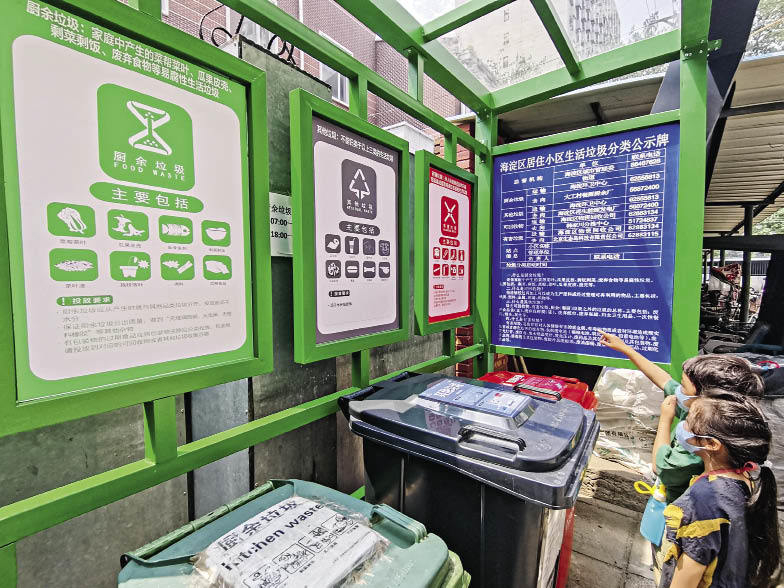
Posters illustrating waste classification have been put up in a neighborhood in Haidian District, Beijing.
Do It Right
The general public is open to the idea of waste classification, but initially there has been confusion regarding the appropriate way to go about it, such as how to differentiate between “kitchen waste,” “recyclables,” “hazardous waste,” and “other waste.” What to do when one cannot decide which waste goes in which bin? People often need help answering such questions.
In Sidao Street of Qingyang District, Chengdu City of Sichuan Province, a 150-meter stretch of wall is painted with instructional murals on the theme of waste classification. In the cartoons, Sichuan’s iconic giant panda cubs ask questions like, “Why do we need waste classification?” and “How do we put the recyclables to an environment-friendly use?” In response, their teacher, the deer, provides the answers. This kind of public education does not occupy much public space but effectively grabs public attention.
Local authorities have also developed games and other activities for residents’ participation. In one of them, kids put out dummy bins for different categories of waste, and watch their parents attempt to put items in the suitable bins respectively. In this manner, waste sorting gradually takes root among the people, and the concept of living green is embraced across society.
Xiong Feiyue, a community worker in Sidao Street, observed that thanks to community efforts, local residents are faring better in waste classification.
In Beijing, many organizations have rolled out programs on waste sorting. The Women’s Federation, for instance, inaugurated a “beautiful home” initiative in March, calling for local students to create paintings, cartoons, and other creative works with their parents on the theme. Feng Yichen of the Anwai Santiao Primary School wrote a computer program on distingushing items about which many feel confused as to what category they belong to, such as expired medicine, and packages for hotpot sauce.
Baidu, China’s leading search engine, developed an app that allows users to find answers for their questions on waste sorting by means of audio, video, and text.
Do It All Together
Waste classification needs the willing participation of society in its entirety.
After dinner, Mr. Wu, who lives on Sidao Street, carries the kitchen waste out to the designated bins in his community. After disposing the bags, he takes out his mobile phone and scans the QR code on the bin using an app whose name plays on the Chinese pronounciation of the phrase “let’s do classification together.” The scanning adds points to his account, and when certain amounts are reached, they can be used to buy trash bags and other items of daily use at the community store.
“We sorted garbage before, but not as thoroughly as we are doing now,” said Mr. Wu. “Now there is a seperate bin for hazardous waste, and we can earn points for classification.” There are similar programs in other cities that award waste sorting with incentives, which allow citizens to see the tangible benefits of the practice.
Communities located in the West Chang’an Avenue area of Beijing take it one step further, integrating waste classification with poverty alleviation. The points residents earn can be exchanged for farm products from poverty-sticken areas through WeChat. This greatly aroused the interest of local residents, and immediately won their support. Community officials are planning to expand the range of farm products for this program to further increase its appeal.
Assorted in Transport
Transport is a key link in the process of classified waste disposal. Some citizens ask the question, “Will the garbage I take great pains to sort mix up again in the dump truck?” To monitor the waste transport process, Jianggan District of Hanzhou City in Zhejiang Province developed a smart management system. Every gargage truck operating in the district has at its rear a sensor half the size of a shoebox which measures the weight of bins before and after each dumping, and in this way culculates the load of each operation. The accuracy rate of the aforementioned measurement is above 99 percent. The trucks are also equipped with cameras, which film the colors and signs on waste bins, along with the activity of the truck workers. After that, the information is transferred to a database as evidence for law enforcement and industry regulation.
Under the smart management system, the movement of garbage trucks is monitored in real time through GPS devices installed in them. By comparing it to the preset routes, regulators can follow the process of waste collection in the area.
All the above information is available as solid evidence needed for settlement of any disputes that may arise in the course of law enforcement.
At the end of the waste disposal chain are treatment and recycling facilities. At the phase II project of the Laogang Renewable Energy Center in Shanghai, six wet garbage processing lines are operating at full steam, handling 1,200 tons per day; and its recycled building materials facility, now under construction, is expected to produce 56,000 baking-free bricks every day. At the center, domestic waste is fed into advanced machines and turned into electricity, bricks, cement, and other useful materials.
“Waste classification is an integrated process in which every link is interconnected,” said Professor Yuan Xingzhong of College of Environmental Science & Engineering, Hunan University. “Waste should be well sorted before collected, transported, and treated. Only by doing so can the practice deliver real results that citizens can see for themselves.” He proposed that products made of recycled materials carry prominent labels, so that customers can feel the tangible effects of waste sorting.
___________
YE XIAONAN & ZHU RUNHUA are reporters of People’s Daily.